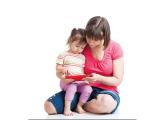Feeling reflective? Try these creative ways to extend play from Kirstine Beeley…
Adding interest
Mirrors are a great resource for early years settings as they not only offer plenty of opportunities to explore and investigate our environments, but also provide added interest to other traditional elements of play – for example, adding mirrors to block play creates an exciting new twist on a popular activity.
What to try
Try adding mirrors to the back of a cupboard or unit as a backdrop to your block play; alternatively use mirror tiles over an old pallet to provide an enticing reflective surface. You can even add sticky mirror film (readily available online) to the blocks themselves to create an extra magical invitation to play.
Something extra
For a cheap alternative to actual mirrored surfaces, why not wrap your blocks in tinfoil? This will provide both added visual interest and new textures to explore. Your children will have great fun building shiny towers and other structures.
Take it further
The benefits of messy play are well documented – it’s brilliant for both sensory and physical development. Introducing mirrors to your messy play offers children yet another dimension to explore.
What to try
Using mirrors as a foundation for clay play, shaving foam and even paint works well – they provide a smooth surface with satisfying potential to explore patterns and symmetry. Imagine smearing colours across the mirror or building clay constructions that appear to double in height! Shaving foam and window cleaning squeegees alongside tabletop and wall-mounted mirrors build gross motor strength and coordination in arms.
Something extra
For a less messy alternative to the suggestions above, try adding coloured rice, sand or salt to a mirrored surface, and then providing paint brushes for the children to practise their mark making skills.
Creative reflections
Collecting a range of smaller mirrored surfaces from charity shops and car boots sales will give you beautiful surfaces that can be introduced to children’s loose parts play, helping to promote creativity in their experiments with transient art.
What to try
Offer mirrors alongside coloured glass beads, matchsticks and lolly sticks, as well as Christmas tree beads, and watch as children develop their own designs and patterns. This is great for both developing problem-solving skills and early maths exploration. If you use a big wall mirror on the floor, children are encouraged to work alongside each other to develop their own ideas whilst exploring reflections, shape, colour and symmetry.
Something extra
It’s a good idea to cover the mirrors you use with some clear, sticky plastic – this will help to minimise the risk of any potential breakages during enthusiastic artmaking!
Explore the unique properties of liquid and reflective surfaces…
It’s really easy to introduce mirrored surfaces to your water play, indoors and out. Simply put a mirror into the bottom of your water tray, or wrap the tray in tinfoil or a shiny survival blanket before filling. Add to the reflective water play fun by using a range of metallic treasures such as jugs, cups and kettles in steel, copper and brass for scooping and pouring. Adding other reflective objects such as old CDs, glitter and silver Christmas tree beads adds extra excitement to the activity!
Kirstine Beeley is an independent trainer, author and consultant, with experience of teaching in early years, primary and SEN settings.

Early years reading – Take story time on screen
Editors picks
